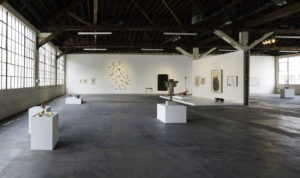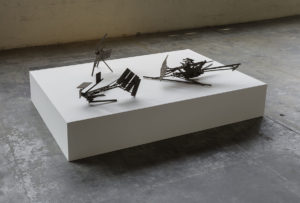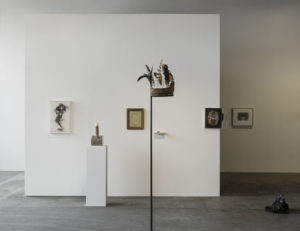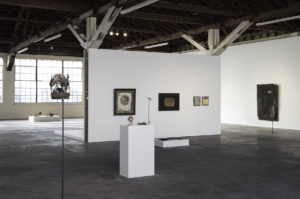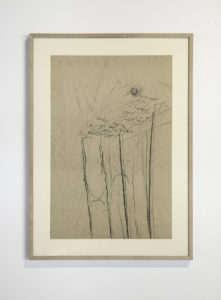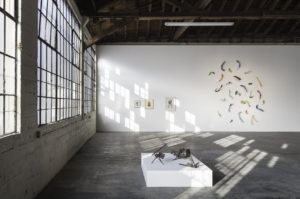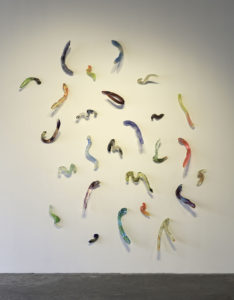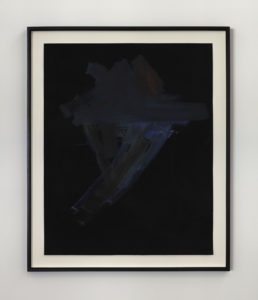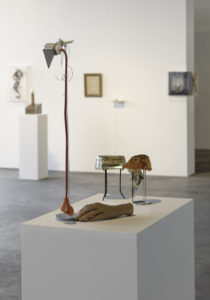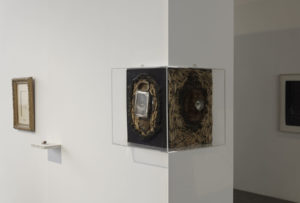Sunlight arrives only at its proper hour
- Conversation between Mitchell Algus & Olivia Shao, curators of "Sunlight arrives only at its proper hour" (en | es)
Olivia Shao: Maybe we should start with talking about our ideas and what we were thinking about for this show?
Mitchell Algus: We started, I suppose, with work we liked and then just…
OS: …bounced ideas off of each other.
MA: Yeah, just proposed one artist and then proposed another.
OS: It was really a back and forth game between the two of us.
MA: So it’s work that we think about a lot and work that means a lot to us and work which has been in our head for years. A lot of it just comes out of our tastes…
OS: …and interests. And we were trying to figure out a way to show all of it. Should we talk about some of the themes?
MA: Theme and sensibility are separate things, I guess. We have a sensibility and then bouncing back and forth individual sensibilities, themes start to arise. What themes do you see?
OS: There’s a Science Fiction theme, then the idea of alchemy, surveillance, spirituality, reflection, metaphysical aspects that tangentially link the works together.
MA: I think when it’s individual sensibilities at play that there are a lot of things going on underneath the surface, which often you don’t see. Because group shows often start off with a specific idea or reflect collective sensibilities they are usually not that personal. If they’re personal and people think they’re personal… well, personal these days often has to do with consensus. It’s really not so much what I think, but what me and my friends think and what we agree on. Or what I can put out there and can get them to agree on. So a lot of the way the art world networks now has to do with that consensus rather than individual sensibility. So in that way I think that this show will be very different.
OS: I think there’s this kind of reflection and mirroring with these pieces. The connection between Tony Conrad, Eric Orr, and then Harold Mendez. There’s also these nice connections between Deborah Remington and Magalie Comeau and of course with the Tom Rankin, which we really like, and his ideas of time travel.
MA: We do like it. And a lot of this work is not well known historically, or completely unknown except to a very, very small group of people. An artist like Tom Rankin, who essentially disappeared – he was in NY for maybe 5 years and making work and got attention, but disappeared and when you take that work out, you think where did this come from? It looks very fresh and to put it into context between contemporary and historical work, really gives us something to think about.
OS: For example, the works by Jean-Léon Gérôme (Amor Holding the Mask of Medusa, 1887) and Nicolas Ceccaldi (Wings, 2007): – it’s something from the 19th century mixed with the contemporary. They all sit together really nicely and look so current.
MA: It’s not that difficult to do, but it’s rarely done, is to take period work and put it in a contemporary context. And people usually think that period work either belongs in museum or belongs with very specialized private dealers, they don’t realize how accessible it is.
OS: It’s nice to take it out of that context.
MA: It’s rare to include in shows of contemporary work. So just being available, and being able to show that and to bounce off other work is something you don’t see very often. It’s also trying to open the art world to look at things with a larger perspective. And not just in historical terms, but to take historical work and bring it into a personal perspective. I won’t say contemporary perspective, but a personal perspective.
OS: We also like the relationship between the works by Harold Mendez and Robert Mallary.
MA: Mendez is a young artist who is just starting to gain attention.
OS: Yeah, he recently moved to Los Angeles from Chicago and he’s in the current Whitney Biennial. The works also have a nice relationship to the Bill Hayden horn (ohoul, 2012)
MA: Which has again, ideas of alchemy with objects that have symbolic meaning.
OS: In a way, there are a few different meanings. A slight sexual meaning as well as when you put the horn to your ear, there’s a wind-tunnel effect that suggests time travel.
MA: To go back to Tom Rankin, this piece was made in 1977, when a group of artists were using materials that could be found on Canal Street in New York. In one way this was a reply to a renewed interest in constructivism, but also anti-hippie, really starting to think about a punk sensibility would mean: evoking Cyberpunk with an interest in science fiction and trying to put a stake in the crunchy granola ideas floating around of the time. For sure it was a neo-futurism.
OS: I love the Vladimir Tatlin, ray-gun aspect of the work.
MA: And it shows a shared sensibility with Deborah Remington paintings which were done 15 years prior to then, so the same sort of desires, an interest in science fiction and making something in this world that is imaginary and be able to really precisely –exactly – replicate something that doesn’t exists, as an art object, gives it a much more forceful reality.
And in relation to Magalie Comeau which is extremely atmospheric, done by a young Quebecois artist who is unknown in the United States, which shows you the politics of the art world and how much getting your work out and getting your work defined depends on who you are, where you are and who is supporting you. Art is always intimately tied to the situation in which it’s made and shown.
OS: Her work has very formal qualities that echoes the architecture of the gallery and also sits with the space. The other work by Comeau in the exhibition is very intense – somewhat dark and creepy.
MA: There’s a corporeal aspect to it. A sense of blood which is being vaporized, as if a body is being absorbed by its architecture and being vaporized to the point where it disappears.
It’s interesting how mythologies, alchemies and archaeologies are showing up in works by Mendez, Ceccaldi, Gerome, Fernandez, in which they are taking objects that are loaded symbolically and refining them into objects which are fully modern.
OS: Terry Fox’s work Stake and Egg (2007), there are connections to his organic materials. The work is based on one of my favorite books “Impressions of Africa” by Raymond Roussel, 1910.
MA: Usually people think of Terry Fox in terms of west coast conceptualism and people think about conceptualism as being academic, while artists like Terry Fox and Eric Orr had much more metaphysical desires. That leads us into the works by Yuji Agematsu, where he’s collecting garbage.
OS: Detritus on the street and cataloguing it. They become their own worlds. One work, “zip: 09.01.06…09.30.06, 2006”, 2006 is the month where he collected the plastic wrapping around a cigarette box and added his findings inside the cellophane wrappers.
MA: And each one serves as a small diorama of his travels of his day and what he picked up. Each one is sort of a diary for that day.
OS: It reflects everything that has happened that whole month. This one is the month of September 2006. They are perfect little days and worlds. Speaking of garbage, the garbage bag on the floor is a slow moving sculpture by the artist Robert Breer called Tucson Rug, 2009. Breer was a filmmaker, painter, and sculptor. He developed several of these motorized sculptures called Floats that move slowly and randomly through the space.
MA: This is something that has been done a lot, like Robert Mallary who in the late 1950’s and early 1960’s took junk from the street and in the context of the assemblage of Rauschenberg and Neo-Dada. Mallary was presenting in an art context and this at the time a political statement about what art does and what art could be.
OS: Yuji Agematsu is more ethereal though, it’s heavy and but then at the same time there’s a weightlessness to it.
MA: Artists are very good at taking junk and making it into something that deserves attention. Next to one of the Agematsu works is a drawing by Hans Bellmer (Untitled, 1930), an early drawing of a dog which verges on being amorphous. The Bellmer drawing is being shown next to a very early work by Matt Hoyt (Untitled, 1998), which is a very realistic looking mouse but one which is totally fabricated, made out of putty and hair.
OS: It’s pretty uncanny.
MA: These two little nasty looking animals are in dialogue with each other, in dialogue between the 1938 and 1998. Then these are next to a fetishistic Agustin Fernandez, assemblage (Book Cover, 1975). It’s actually a book cover with collage and photographs, possibly by Robert Mapplethorpe, a close friend of the artist.
OS: I love the way it hangs in the corner. It’s a clever piece. And then our favorites, Unica Zürn, Hans Bellmer’s partner. Her father was an officer stationed in Africa and I believe he would her bring back books. A lot of her influence was from imaginary animals and she only made about 75-80 of these drawings (both Untitled, 1960).
MA: She did relatively few. She had psychological problems and ended up committing suicide around 1970. In a sense, these are her demons.
OS: Really? You think of them as her demons?
MA: Well, no. Maybe they are her companions.
OS: I think they’re more surreal and otherworldly, and maybe these were made to help her work through her demons.
MA: There are a number of California west coast artists in the show; Jay DeFeo, Deborah Remington, Jeremy Anderson, Terry Fox, Mike Kelley, Tony Conrad, Eric Orr…
OS: And of course Cameron, who was a big part of the underbelly of LA subculture involving mysticism with OTO (Ordo Templi Orientis) and Jack Parsons, this kind of occultist dark magic.
MA: This kind of interest in dark magic, Satanism, etc. goes through surrealism and really permeates a lot of the work which in the show and that’s just a matter of sensibility and taste that informs things we find engaging and interesting. I think this brings us to Lee Bontecou. One of the ideas that goes through most of the work and that Lee Bontecou brings to the surface is how beautifully made a lot of these objects are. Questions of quality and craft, which people rarely talk about, really make a difference. There are a lot of drawings in the show because that level of craft and service to sensibility and message, really comes out in drawing and people need to be able to see that. To talk about quality seems superficial, but it’s very deep. Bontecou is perfect to demonstrate that.
OS: The Michael E. Smith piece (Untitled, 2015), which is a car seat from a police vehicle, a prisoner transport seat with a sunflower stalk diagonally across it. He has an interesting way of putting materials and objects together, – very disparate objects or materials. There’s an intensity in this that I think is missing from a lot of work these days. His work definitely has that quality.
MA: Agustin Fernandez’s Sculpture, 2003, is a work that contains the materials that the Plexiglas exterior was wrapped in, that had to be peeled off. Then the peeled off material for the protection of the Plexiglas was encased within the Plexiglas…so in a way, it’s a sculpture that makes itself.
OS: Or it’s the skin of the box. The outside becomes contained in the inside. There’s something surrealist about that.
MA: The box contains its skin. Nearby, the Jeremy Anderson sculpture (Untitled, 1949) which comes out of surrealism, working with biological forms in the 40’s and 50’s. It’s a stone sculpture from an artist who is perhaps better known for his work in wood, showing an interpretation of surrealist sensibility in a California context.
OS: It’s taken out of the mid-century but in the show looks less mid-century and more alien.
MA: It’s nice to take mid-century work that is difficult to extract from its time or a certain nostalgia and strip it from that and put it in a new context or place.
OS: And in conjunction with Bill Leavitt’s work Ellipsoidal Lights, 1986 which has this sort of alien, spaceship kind of feel with a landscape and these columns of glowing orbs.
MA: What’s nice about Bill Leavitt’s work is that a lot of it comes out of stage and set design. You realize that, in a way, the things being depicted have already been examined for how they communicate clichés’ and then trying to circle back on that to remove It and see those clichés or those conventions in a new light. This was on of the things about Levitt’s work that appealed to the “pictures” artists in New York.
OS: Finally, we should talk about Nancy Arlen, Steve Keister and Henri Michaux works. The large Nancy Arlen work is titled Comet, 1981 and it’s made up of these squiggly, brightly colored, cast resin pieces. This is the sunlight aspect of the show.
MA: It’s nice to see this piece installed. It is a big piece that has probably been only shown twice in the early 1980’s and has never been shown since. It’s one of Nancy’s major pieces and it’s really great to see it out again. In a way, it’s a quintessential 1980s piece; brightly colored, relief…
OS: But, I don’t think it feels 1980s.
MA: Yeah, it looks totally new. It’s great to see work that hasn’t been shown in a long time, that you might think would be trapped in a historical context, and see that its incredibly fresh and easily shakes all of those bonds. In relation to the Nancy Arlen piece, we have Steve Keister’s Stingray that is one of his last suspended works from 1986. It’s a spandex form that is stretched from points, giving topological curves, but hardened with fiberglass so that the form retains its shape. This artist became well known for suspended sculptures and this is the last of those.
OS: It’s a great form. It’s hovering like a UFO or drone.
MA: It’s in the middle of the show and seems to relate to just about everything, which is a great part of the show. Everything bounces back and forth, echoing and reflecting. And at the entrance to the show is an 1890 crucifixion figure by John Singer Sargent that was a model for his Boston Public Library. Olivia and I loved this work and the idea of placing it at the entrance to the show is both confrontational and welcoming. Hopefully it will serve to reset the art world’s expectations about what one can get from shows like this.
OS: Finally, we get to the Henri Michaux drawing.
MA: The title of the show, Sunlight arrives only at its proper hour is a line form one of his prose poems, “I Am Writing to You from a Far-Off Country” (published in 1938). We thought this was fitting for LA and fitting for our show. To bring lightness out of dark. It shows a loosely drawn figure and Michaux was well known for his mescaline drawings. He was a poet, writer and artist, associated with the surrealists but really independent. He was his own thing. And this work is an embodiment of our show’s title.
Entrevista de curaduría a cargo de Mitchell Algus y Olivia Shao (en | es)Olivia Shao: Tal vez deberíamos empezar hablando de nuestras ideas y lo que pensábamos al organizar la muestra.
Mitchell Algus: Empezamos, supongo, con obras que nos gustaban y después…
OS: … compartimos ideas entre nosotros.
MA: Sí, propusimos un artista y luego otro.
OS: En realidad fue un juego de intercambio entre nosotros dos.
MA: Es obra en la que pensamos mucho y que significa mucho para nosotros, que hemos tenido en mente durante años. En gran parte viene de nuestros gustos…
OS: … e intereses. Y buscábamos una manera de mostrarlo todo. ¿Hablamos de algunos de los temas?
MA: Tema y sensibilidad son dos cosas distintas, supongo. Tenemos sensibilidad y cuando compartimos idas sobre nuestra sensibilidad individual empiezan a surgir temas. ¿Qué temas ves?
OS: Uno de los temas es la ciencia ficción. Luego está la idea de la alquimia, vigilancia, espiritualidad, reflexión, aspectos metafísicos que relacionan las obras tangencialmente.
MA: Me parece que cuando entran en juego las sensibilidades individuales hay muchas cosas debajo de la superficie que a menudo no ves. Debido a que las exposiciones colectivas empiezan a menudo con una idea específica o reflejan sensibilidades colectivas, no suelen ser muy personales. Si son personales y la gente piensa que lo son… bueno, hoy en día lo personal muchas veces tiene que ver con el consenso. En realidad no se trata tanto de lo que pienso yo, sino lo que pensamos mis amigos y yo, algo en lo que estamos de acuerdo. O lo que yo puedo sacar y con lo que que ellos concurran. Entonces, gran parte de la manera en las que hoy interactúa el mundo del arte tiene que ver con ese consenso más que con la sensibilidad individual. En eso creo que este show va a ser muy diferente.
OS: Creo que hay una especie de reflexión y de reflejo en estas piezas. La relación entre Tony Conrad, Eric Orr, y luego Harold Mendez. También hay una conexión muy chula entre Deborah Remington y Magalie Comeau, y desde luego con Tom Rankin, que nos gusta mucho, y sus ideas de viaje en el tiempo.
MA: Sí nos gusta. E históricamente, gran parte de esta obra no se conoce mucho, o es totalmente desconocida excepto para un grupo muy reducido de personas. Un artista como Tom Rankin, que básicamente desapareció –estuvo en Nueva York más o menos por 5 años creando obra y recibió atención, pero desapareció y cuando sacas esa obra, te preguntas, ¿y esto de dónde salió? Se ve muy fresco y contextualizarlo entre obra histórica y contemporánea realmente nos da algo sobre lo que pensar.
OS: Por ejemplo, las obras de Jean-Léon Gérôme (Amor sosteniendo la máscara de Medusa, 1887) y Nicolas Ceccaldi (Wings/Alas, 2007)—es algo decimonónico mezclado con lo contemporáneo. Todo se ajusta muy bien y se ve muy actual.
MA: No es tan difícil de lograr, pero se hace poco, tomar obras de época y colocarla en un contexto actual. Y por lo general la gente piensa que las obras de época deben estar en museos, o con marchantes privados muy especializados. No se dan cuenta de lo accesibles que son.
OS: Es bueno sacarlas de contexto.
MA: No es frecuente incluirlas en muestras junto a obras contemporáneas. Entonces, simplemente hacerlas disponibles, y poder mostrarlas y que dialoguen con otras obras es algo que no se ve a menudo. También es tratar de abrir el mundo del arte para mirar cosas desde una perspectiva más amplia. Y no sólo en términos históricos, sino tomar obras históricas y darles una perspectiva personal. No voy a decir una perspectiva actual, pero una perspectiva personal.
OS: También nos gusta la relación entre las obras de Harold Mendez y Robert Mallary.
MA: Mendez es un artista joven que recién empieza a recibir atención.
OS: Sí, se mudó hace poco de Chicago a Los Ángeles y está en la actual Bienal del Whitney. Las obras tienen una relación interesante con el cuerno de Bill Hayden (ohoul, 2012).
MA: Que también tiene ideas de alquimia con objetos que tienen un significado simbólico.
OS: De algún modo hay algunos significados diferentes. Un sentido ligeramente sexual además de que cuando te pones el cuerno al oído se crea un efecto de túnel de viento que te da la sensación de viajar en el tiempo.
MA: Volviendo a Tom Rankin, esta pieza se creó en 1977, cuando un grupo de artistas usaban materiales que se podían encontrar en Canal Street, en Nueva York. De algún modo era una respuesta al interés renovado en el constructivismo, pero también anti hippy, empezando a pensar en lo que significaría una sensibilidad punk: evocar el ciberpunk a través del interés en la ciencia ficción y tratar de ponerle una chuleta a las ideas de granola que andaban flotando en esa época. De seguro era un neofuturismo.
OS: Me encanta el elemento de la pistola de rayos a lo Vladimir Tatlin de la pieza.
MA: Y muestra una sensibilidad compartida con los cuadros de Deborah Remington que se habían ejecutado 15 años antes, así que los deseos, un interés en la ciencia ficción y traer algo al mundo que es imaginario y poder precisamente, exactamente, replicar algo que no existe, como objeto de arte, le da una realidad mucho más fuerte.
Y relacionarla con la de Magalie Comeau, que es muy atmosférica, creada por una artista de Quebec desconocida en Estados Unidos, que te muestra la política del mundo del arte y cuánto depende el que tu obra se haga visible y sea definida depende de quién eres y quién te apoya. El arte siempre se relaciona íntimamente con la situación en la que se produce y se expone.
.
OS: Su obra tiene cualidades muy formales que reflejan la arquitectura de la galería y también queda bien en ese espacio. La otra obra de Comeau que hay en la exposición es muy intensa, un poco oscura y perturbador.MA: Tiene algo de corpóreo. Algo como sangre vaporizada, como si un cuerpo estuviera siendo absorbido por su arquitectura y vaporizado al punto de desaparecer.
Resulta interesante cómo las mitologías, alquimias, y arqueologías aparecen en obras de Menndez, Ceccaldi, Gerome, Fernandez, en las que toman objetos cargados de simbolismo y los refinan hasta convertirlos en objetos totalmente modernos.
OS: La obra Steak and Egg (Carne y huevo, 2007) de Terry Fox tiene conexiones con sus materiales orgánicos. La obra está basada en uno de mis libros favoritos, Impresiones de África, de Raymond Roussel, 1910.
MA: Por lo general la gente piensa en Terry Fox en términos del conceptualismo de la costa Oeste, y la gente piensa en el conceptualismo como algo académico, pero artistas como Terry Fox y Eric Orr tenían muchos deseos metafísicos. Eso nos lleva a las obras de Yuji Agematsu, donde recoge basura.
OS: Desechos de la calle que cataloga. Se convierten en sus propios mundos. Una obra, “zip: 09.01.06…09.30.06, 2006”, 2006 es el año en el que recogió el envoltorio plástico de una caja de cigarrillos y lo le añadió a los envoltorios de celofán las cosas que encontraba.
MA: Y cada una sirve como un pequeño diorama de sus viajes, de su época y de lo que recogía. Cada uno es una especie de diario de ese día.
OS: Refleja todo lo que sucedió en todo ese mes. Este es el mes de septiembre de 2006. Son pequeños días y mundos perfectos. Hablando de basura, la bolsa de basura que hay en el piso es una escultura de muy lento movimiento que el artista Robert Breer tituló Tucson Rug (Alfombra de Tucson, 2009). Breer era cineasta, pintor y escultor. Desarrolló varias de estas esculturas motorizadas que llamó floats (carrozas), que se mueven lenta y fortuitamente por el espacio.
MA: Esto es algo que se ha hecho mucho, como Robert Mallary, que a finales de la década de 1950 y principios de los 60 recogía basura de la calle en el contexto del ensamblaje de Rauschenberg y el Neo-Dada. Mallary lo presentaba en un contexto artístico y eso, en esa época, era una declaración política sobre lo que hace y lo que podría ser el arte.
OS: Pero Yuji Agematsu es más etéreo, es duro, pero al mismo tiempo tiene una cierta ingravidez.
MA: Los artistas son muy buenos agarrando basura y transformándola en algo que merece atención. Junto a una de las obras de Agematsu hay un dibujo de Hans Bellmer (Sin título, 1930), un dibujo temprano de un perro que raya lo amorfo. El dibujo de Bellmer se muestra al lado de una obra muy temprana de Matt Hoyt (Sin título, 1998) que es un ratón muy realista pero que es totalmente fabricado; está hecho de plastilina y pelo.
OS: Es bastante extraño.
MA: Estos dos animalitos horribles dialogan entre sí, un diálogo entre 1938 y 1998. Después los dos están al lado de un ensamblaje fetichista de Agustín Fernández, (Book Cover/ Portada de libro, 1975). Es la portada de un libro con collage y fotografías, seguramente de Robert Mapplethorpe, un buen amigo del artista.
OS: Me encanta cómo cuelga en la esquina. Es una pieza ingeniosa. Y luego nuestros favoritos, Unica Zürn, la compañera de Hans Bellmer. Su padre era un oficial destinado en África y creo que le traía libros. Tiene mucha influencia de animales imaginarios y sólo hizo 75 u 80 de estos dibujos (ambos Sin título, 1960).
MA: Hizo relativamente pocos. Tenía problemas psicológicos y terminó suicidándose hacia 1970. De alguna manera, son sus demonios.
OS: ¿De veras? ¿Los consideras sus demonios?
MA: Bueno, no. A lo mejor son sus compañeros.
OS: Créo que son más surreales y de otro mundo, y a lo mejor los creó para lidiar con sus demonios.
MA: Hay una serie de artistas californianos de la costa oeste en la exposición: Jay DeFeo, Deborah Remington, Jeremy Anderson, Terry Fox, Mike Kelley, Tony Conrad, Eric Orr…
OS: Y, desde luego, Cameron, que fue una parte importante del bajo vientre de la subcultura de Los Ángeles relacionada con el misticismo, con OTO (Ordo Templi Orientis) y Jack Parsons, ese tipo de magia negra ocultista.
MA: Este interés en la magia negra, el satanismo, etc. Pasa por el surrealismo y permea mucho del mundo que se presenta en la exposición y eso solo una cuestión de sensibilidad y gusto que informa las cosas que consideramos atrayentes e interesantes. Creo que eso nos lleva a Lee Bontecou. Una de las ideas que atraviesa gran parte de la obra y que lee Bontecou saca a la superficie es lo primorosamente que están hechos muchos de estos objetos. Las cuestiones de calidad y lo artesanal, de las que la gente habla poco, realmente destacan. Hay muchos dibujos en la muestra porque el nivel artesanal y la atención a la sensibilidad y al mensaje realmente resaltan en el dibujo, y la gente tiene que poder ver eso. Hablar de calidad parece superficial, pero es algo muy profundo. Bontecou es una prueba perfecta de ello.
OS: La pieza de Michael E. Smith (Sin título, 2015), es el asiento de un vehículo policial, un asiento de transporte de detenidos con un tallo de girasol colocado a su ancho. Tiene una forma interesante de juntar objetos y materiales –objetos o materiales muy dispares. Hay en la pieza una intensidad que me parece que le falta a muchas obras en estos días. Su obra sin duda tiene esa cualidad.
MA: Sculpture/ Escultura (2003) de Agustín Fernández es una obra que contiene materiales envueltos en el exterior de Plexiglás, luego se le arrancó el material que protegía el Plexiglás y se lo recubrió de Plexiglás… de algún modo es una escultura que se hace sola.
OS: O es la piel de la caja. El exterior se convierte en el contenido. Eso tiene algo de surrealista.
MA: El envoltorio contiene su piel. Ahí cerca, la escultura de Jeremy Anderson Sin título, 1949, que surge del surrealismo, explora formas biológicas en la década de los 40 y 50, es una escultura en piedra de un artista que tal vez sea más conocido por su obra en madera, mostrando una interpretación de la sensibilidad surrealista en un contexto californiano.
OS: Está tomada de mitad de siglo, pero en esta muestra parece menos de mitad de siglo y más extraña.
MA: Está muy bien tomar obras de mediados de sigo que resulta difícil de sustraer de su tiempo o de cierta nostalgia y sacarla de eso para colocarla en un contexto o un lugar nuevo.
OS: Y está junto a la obra Ellipsoidal Lights/ Luces elipsoidales de Bill Leavitt, 1986, que da esa sensación de nave espacial, medio extraterrestre, con un paisaje y esas columnas de esferas brillantes.
MA: Lo bueno de la obra de Bill Leavitt es que gran parte de ella surge del decorados y escenografías teatrales. Te das cuenta de que, en cierto modo, las coas que se representan ya se han explorado en la manera en la que comunican clichés y luego tratar de tener eso en cuenta para eliminarlo y tratar de ver los clichés o las convencionalidades desde otra perspectiva. Esta era una de las cosas sobre la obra de Levitt que agradaba a los artistas de “dibujo” en Nueva York.
OS: Finalmente, deberíamos hablar de las obras de Nancy Arlen, Steve Keister y Henri Michaux. La obra de gran formato de Nancy Arlen se titula Comet/Cometa, 1981, y consiste en esas piezas onduladas de colores brillantes moldeadas en resina. Es el elemento soleado de la muestra.
MA: Es bueno ver esta pieza instalada. Es una pieza grande que seguramente se expuso sólo dos veces a principio de la década de 1980 y no se ha exhibido desde entonces. Es una de las piezas más importantes de Nancy, y es excelente verla surgir otra vez. De cierta manera es una pieza esencial de la década de 1980: de colores vivos, relieve…
OS: Pero no me parece que se siente de los 80.
MA: Sí, parece totalmente nueva. Es estupendo ver obra que no se ha mostrado en mucho tiempo, que piensas que estaría atrapada en su contexto histórico, y ver que es extraordinariamente fresca y que se libera fácilmente de todos esos vínculos. En relación a la pieza de Nancy Arlen tenemos Stingray de Steve Keister, una de sus últimas obras en suspensión, de 1986. Es una forma de spandex que se extiende en nos puntos creando curvas topológicas endurecidas con fibra de vidrio para que mantenga la forma. Este artista fue muy reconocido por sus esculturas suspendidas y ésta fue la última de ellas.
OS: Es una forma excelente. Flota como un platillo volante o un dron.
MA: Está en mitad de la exposición y parece relacionarse con casi todo, lo que lo hace una gran parte de la muestra. Todo rebota de un lado a otro, es como un eco, una reflexión. Y en la entrada de la exposición está la imagen de la crucifixión, de John Singer Sargent, de la década de 1890 que le sirvió de modelo para la biblioteca pública de Boston. A Olivia y a mí nos encanta esta obra y la idea de ponerla en la entrada de la exposición es a la vez desafiante y acogedor. Espero que sirva para reajustar las expectativas del mundo del arte sobre lo que uno puede sacar de una muestra como esta.
OS: Finalmente, tenemos el dibujo de Henri Michaux.
MA: El título de la exposición es Sunlight arrives only at its proper hour/ La luz del sol sólo llega a la hora adecuada, un verso de uno de sus poemas en prosa: “Te escribo desde un país lejano” (publicado en 1938). Pensamos que esto era adecuado para Los Ángeles y para nuestra exposición. Sacar la luminosidad de la oscuridad. Muestra una figura esbozada, y Michaux era conocido por sus dibujos influido por la mezcalina. Era un poeta, escritor y artista asociado a los surrealistas, pero realmente era independiente. Era su propia cosa. Y su obra encarna el título de nuestra exposición.
- Select Reviews
Sunlight arrives only at its proper hour
Curated by Mitchell Algus and Olivia Shao
June 2 – July 30, 2017
With works by: Yuji Agematsu, Nancy Arlen, Jeremy Anderson, Hans Bellmer, Bill Bollinger, Lee Bontecou, Robert Breer, Dan Burkhart, Cameron, Nicolas Ceccaldi, Magalie Comeau, Tony Conrad, Jay DeFeo, Michaela Eichwald, Agustin Fernandez, Terry Fox, Ilka Gedő, Jean-Léon Gérôme, Bill Hayden, Matt Hoyt, Steve Keister, Mike Kelley, William Leavitt, Lee Lozano, Robert Mallary, Harold Mendez, Henri Michaux, Eric Orr, Tom Rankin, Deborah Remington, John Singer Sargent, Michael E. Smith, and Unica Zürn
Tags: Agustin Fernandez, Bill Bollinger, Bill Hayden, Cameron, Dan Burkhart, Deborah Remington, Eric Orr, Hans Bellmer, Harold Mendez, Henri Michaux, Ilka Gedő, Jay DeFeo, Jean-Léon Gérôme, Jeremy Anderson, John Singer Sargent, Lee Bontecou, Lee Lozano, Magalie Comeau, Matt Hoyt, Michael E. Smith, Michaela Eichwald, Mike Kelley, Mitchell Algus, Nancy Arlen, Nicolas Ceccaldi, Olivia Shao, Robert Breer, Robert Mallary, Steve Keister, Terry Fox, Tom Rankin, Tony Conrad, Unica Zürn, William Leavitt, Yuji Agematsu

